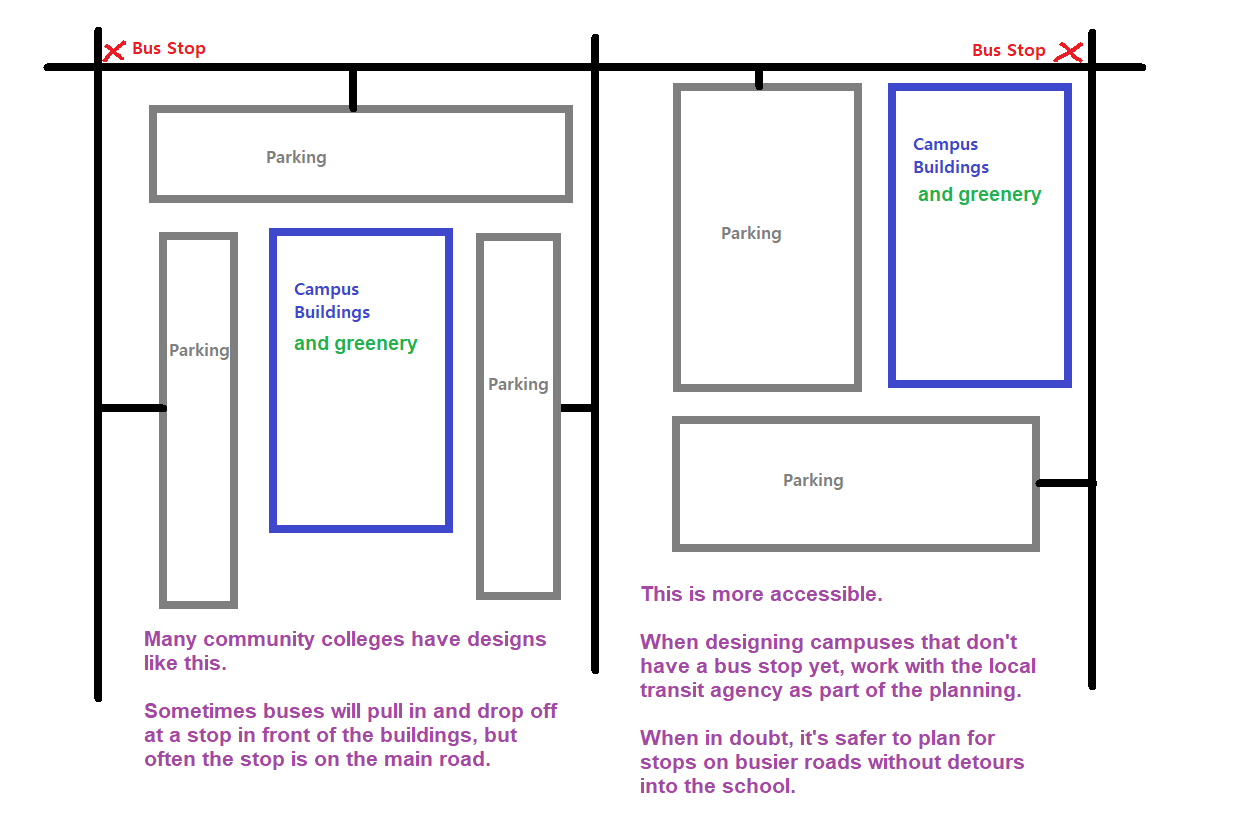On Campus Mentis
by Dr. Matthew Crespi
Phase II of the SHSF Transit Mapping Project continues to chug along. (A train metaphor! People who told me we make too many bus jokes, you’ve been heard!) We’ve spent a lot of time looking at community and technical colleges on various mapping platforms. The point of all this screentime is to find and verify nearby transit stops, but it’s had a side effect: we’ve seen a LOT of layouts of community college campuses.
As you might imagine, when you look at hundreds of campus designs, some patterns emerge. One in particular seemed worth noting and sharing. Some community college campuses are designed similarly to the campuses of residential four-year colleges. In this style, academic buildings are set back from roads and separated by wonderful green space; they wind up scattered throughout or surrounding landscaping that could easily be confused for a park.
This all makes for a pleasant on-campus experience and nice looking spaces, but these community colleges have an added layer of infrastructure that residential schools need less of: parking. Many of these academic oases — quite often in suburbia — sit within rings of parking. For students without cars, especially those with disabilities, these asphalt expanses (and sometimes rings of green space too) between a bus stop and a classroom present physical barriers to entry. In short, layouts designed to make the campus welcoming to one type of student can make it less hospitable to others trying to get to class.
We spent some time studying these campuses, making detailed observations as we collected empirical data. We ran some analysis and produced a figure highlighting our key finding by employing some VERY sophisticated modeling techniques using a software package that most professional designers are familiar with: Microsoft Paint.
Here’s the basic takeaway:
Figure 1: A comparison of campus design options with notes on accessibility.
For schools with a design similar to the one on the left, the local transit agency’s willingness to put a bus stop on the other side of one of those parking lots can make or break a student’s ability to get to class on time. As we’ve shared elsewhere, transit schedules don’t always align with course start times, so students may have very limited time to dash from stop to seat. For students with disabilities, or parents wrangling strollers, or the student rushing to class after work, distance between a stop and school is more than a matter of convenience.
For a real world example that illustrates this kind of inclusive design, let’s look at Montgomery County Community College, in the Philadelphia suburbs:
Figure 2: Satellite photo of Montgomery County Community College. I took Driver’s Ed here!
The center of campus is that nice green quad, surrounded by academic buildings, which are surrounded by parking. Fortunately, SEPTA has a bus stop (and it serves two routes; good for them!) in the Green Lot close to the campus buildings. Not every college gets that kind of consideration, though, especially in commuter-focused transit networks that presumably don’t want to take the time to pull in and out of parking lots. (We’re not going to shame anyone in particular here, though, as we don’t know the stories behind each stop choice.)
This phenomenon is also why, on the original SHSF Transit Map, you might find a college with a stop right at front coded as “0.2 to 0.5 miles from transit” or even “0.5 to 1 mile from transit”! Sometimes that happens when the pin is dropped on the main campus building, and the “stop right out front” is, well, kind of a schlep.
Before going back to our data cleaning, we’d like to once more remind everyone: accessibility isn’t always something you can implement after-the-fact (e.g., you might not be able to rely on the transit agency to put the stop exactly where you want it, especially if you’re building a smaller school with fewer bus riders). Design choices from the very beginning matter! Just because 99% of community college students are commuters, that doesn’t mean that 99% of them own a car. Inclusive design means designing for everyone.



